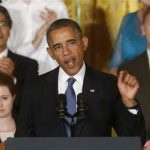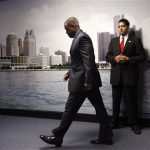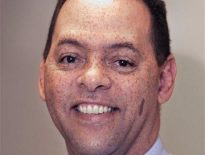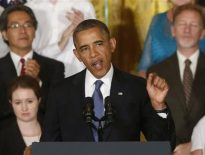SEOUL, South Korea (AP) — Two years after he made history by becoming the Navy’s first black pilot, Ensign Jesse Brown lay trapped in his downed fighter plane in subfreezing North Korea, his leg broken and bleeding. His wingman crash-landed to try to save him, and even burned his hands trying to put out the flames.
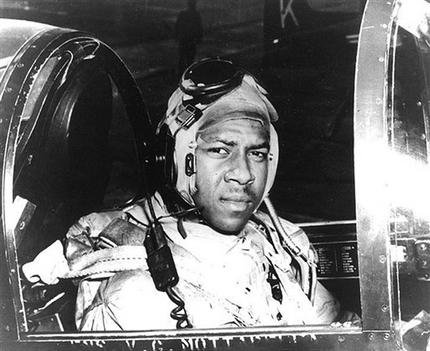
A chopper hovered nearby. Lt. j.g. Thomas Hudner could save himself, but not his friend. With the light fading, the threat of enemy fire all around him and Brown losing consciousness, the white son of a New England grocery-store magnate made a promise to the black son of a sharecropper.
“We’ll come back for you.”
More than 60 years have passed. Hudner is now 88. But he did not forget. He is coming back.
—
Hudner, now a retired Navy captain, heads to Pyongyang on Saturday with hopes of traveling in the coming week to the region known in North Korea as the Jangjin Reservoir, accompanied by soldiers from the Korean People’s Army, to the spot where Brown died in December 1950.
The reservoir was the site of one of the Korean War’s deadliest battles for Americans, who knew the place by its Japanese name, Chosin. The snowy mountain region was nicknamed the “Frozen Chosin,” and survivors are known in U.S. history books as the “Chosin Few.”
The Battle of the Chosin Reservoir lasted for 17 brutal days. Some 6,000 Americans were killed in combat, and thousands more succumbed to the cold. Brown and many others who died there are among more than 7,910 Americans still missing in action from the war.
Though the fighting ended with an armistice signed 60 years ago July 27, North Korea and the U.S. remain technically at war. Efforts to recover remains have come in fits and starts, with little recent progress.
Next week’s mission is to pick up where search teams have left off by locating the exact spot of Brown’s crash. Armed with maps and coordinates, they hope to work with North Korean soldiers to excavate the remote area, a sealed site controlled by the North Korean military.
Approval for the unusual journey comes as North Korea prepares for festivities marking the upcoming armistice anniversary. Pyongyang is expected to use the milestone to draw international attention to the division of the Korean Peninsula as well as to build unity among North Koreans for new leader Kim Jong Un.
Hudner does not plan to stay for a massive military parade expected on July 27. But he said he hopes his visit will help to foster peace and reconciliation on the tense Korean Peninsula.
—
Japan occupied Korea for decades, until the end of World War II. Then the Soviets and the Americans moved in, backing rival fledgling governments and dividing the country halfway at the 38th parallel.
War broke out in June 1950, with the communist North Koreans marching into Seoul. They were countered by U.S.-led U.N. forces that charged north, taking Pyongyang and continuing up the peninsula.
By November, U.S. Marines had dug in around the Chosin reservoir and in Unsan County to the west. The plan was to push north as far as the Yalu River dividing Korea from China.
What they didn’t know was that as many as 100,000 Chinese ground troops had slipped across the Yalu to fight for the North Koreans. They boxed in 20,000 U.N. forces, mostly U.S. Marines.
Hudner and Brown were members of Fighter Squadron 32, dispatched to the region deep in North Korea’s forbiddingly mountainous interior to support the trapped ground troops and carry out search-and-destroy missions.
Theirs was a close-knit squadron. But the two men, both in their 20s, came from completely different worlds.
Hudner, of Fall River, Massachusetts, was a privileged New Englander who was educated at prep school and had been invited to attend Harvard. Brown, of Hattiesburg, Mississippi, broke the Navy’s color barrier for pilots in 1948, months after President Harry S. Truman ordered the desegregation of the U.S. armed forces.
It wasn’t an easy role for Brown to take on, Hudner recalled. “People who didn’t know him gave him a hard time just because he was black.”
But those who got to know Brown grew to respect the serious, unfailingly considerate young man who impressed his peers with his dedication to flying – and his gentle sense of humor.
“The squadron, almost to a man, protected him any way they could,” Hudner told The Associated Press before his departure, his pale blue eyes sparkling. “He was a friend who, I’d say, was beloved by almost everybody who knew him. A very special person.”
Late the afternoon of Dec. 4, 1950, Brown was flight leader of a six-plane formation over the Jangjin Reservoir, a mission like 20 others he had led previously. He paired up with Hudner, who was flying on his right.
This time, ground fire struck Brown’s plane, forcing him to land behind enemy lines. When Brown waved for help from his crumpled, smoking cockpit after slamming into the mountainside, Hudner acted quickly.
“I thought: `My God, I’ve got to make a decision,” he said. “I couldn’t bear the thought of seeing his plane burst into flames.”
Hudner crash-landed his plane in high winds and snowy rocks about 100 yards from the downed fighter. As flames engulfed Brown’s plane, and still under the threat of attack, Hudner scrambled to pack the fuselage with snow, burning his hands in the process. He took his cap off and pulled it over Browns’ ears, then radioed for help as Brown remained trapped in the cockpit, bleeding heavily, his leg crushed and his body temperature dropping in the subzero conditions.
A Marine helicopter arrived, but the pilot and Hudner could not extract Brown from the wreckage.
Before losing consciousness, his thoughts turned to his wife, whose name he whispered in his last command to Hudner: “If I don’t make it, please tell Daisy I love her.”
Hudner reluctantly got into the rescue helicopter. Brown is believed to have died soon after. The next day, U.S. military planes dropped napalm on the wreckage to keep the enemy from getting his body.
Hudner was awarded the Medal of Honor, the U.S. military’s highest award, for trying to save Brown. Brown posthumously received the Purple Heart and the Distinguished Flying Cross.
“He was a leader,” Hudner said. “He had great promise had he not been so tragically killed.”
—
Hudner went onto a distinguished naval career and later served as Massachusetts’ commissioner of veterans’ services, eventually settling in the revolutionary town of Concord, Massachusetts.
A few years ago, he was contacted by author Adam Makos about doing a book on his wartime heroics. It was Makos, Hudner said, who suggested returning to the crash site. Hudner hadn’t thought it possible, given the abysmal state of U.S.-North Korean relations.
They enlisted Chayon Kim, a South Korean-born U.S. citizen who had been involved in the campaign to build a Korean War Memorial in Washington, and who took the Harlem Globetrotters and former NBA star Dennis Rodman to North Korea earlier this year.
She agreed to take Hudner, fellow Korean War veteran Dick Bonelli, and their group to North Korea. Kim, who says she has built ties over the years with the North Korean military, asked the army to supply soldiers to help with the search.
Hudner hopes to bring Brown’s remains home to the aviator’s 86-year-old widow, Daisy, and their daughter, Pam Knight, who was a toddler when her father died.
Going back to Jangjin and finding Brown’s remains “would be closure to me,” Hudner said. “And I’m sure it would be to the family.”
Hudner, who turns 89 next month and is in frail health, is bracing himself for what he knows will be difficult journey. There are few paved roads outside Pyongyang, and the route to the region where Brown died is a steep mountain path, treacherous even in good weather.
“I won’t be at the bar boozing it up for very long when I get there,” he joked.
The political complications may be greater still. The Koreas remain divided by the world’s most militarized border, and Washington and Pyongyang lack diplomatic relations.
Diplomatic forays have sputtered over the years, stalled by a standoff over North Korea’s nuclear ambitions. Earlier this year, Pyongyang threatened to launch a nuclear war if provoked; Washington sent bombers into the region in what defense officials acknowledged was meant as a warning.
America is still Enemy No. 1 to North Koreans, who consider the posting of 28,500 U.S. troops across the border in South Korea to be an “occupation” of the Korean Peninsula.
Hudner is due to arrive at a time known in North Korea as the “anti-American period,” a month devoted to recounting the atrocities allegedly perpetrated by U.S. soldiers during the Korean War and leading up to July 27. Since this is the 60th anniversary of the armistice, it is all the more prominent.
Posters show North Koreans with eyes blazing as they attack American soldiers with bayonets. “Sweep away the imperialist American aggressors,” they read. Students file through exhibition halls that lay out the alleged toll: More than 1.2 million soldiers and civilians killed.
More than 54,000 American military personnel died in Korea fighting as part of the U.S.-led U.N. forces, including the nearly 8,000 never accounted for, according to the U.S. Defense Department.
For decades, the families of missing U.S. soldiers have pressed the government to search for their remains.
The first joint U.S.-North Korea searches began in 1996. Teams uncovered 229 sets of remains, but in 2005, with Washington and Pyongyang locked in a nuclear standoff, the U.S. government suspended the searches, citing security concerns.
Last year, the Joint POW/MIA Accounting Command prepared to resume the search. But those plans were scrapped following North Korea’s decision to launch a long-range rocket – widely seen as a test of missile technology. Additionally, the search program itself has been criticized as “inept” and “dysfunctional” in an internal Pentagon study recently obtained by the AP.
Hudner and the team don’t know if they’ll find Brown’s remains or the wreckage of the two planes.
But Makos, who intends to make the trip the last chapter of his book about the two men, said Brown’s place in history makes it especially important to make the attempt.
“He’s a Jackie Robinson in many ways. He’s a Joe Louis,” he said. “He’s a historic figure, yet he’s lying on a Korean mountainside.”


